Tips and Tricks
Caffeine Cut: How to Avoid Coffee for a Healthier Lifestyle!
Get ready to kick your coffee habit for a healthier lifestyle and discover effective strategies to reduce caffeine intake.

To start living a healthier lifestyle, consider cutting down on coffee to decrease your caffeine consumption. Excessive caffeine can increase the risk of health issues like insomnia and elevated heart rate. Try slowly reducing your intake, keep track of your caffeine consumption in a diary, and switch to decaf or healthier alternatives. Be mindful of your intake, especially if you are pregnant or have underlying health conditions. Embrace changes in your lifestyle that support your well-being. Think about exploring other ways to boost your energy and alertness, such as regular physical activity and a well-balanced diet. Seek assistance from a healthcare provider or therapist to manage caffeine-related anxiety and transition to a lower caffeine lifestyle. Remember, making gradual adjustments can lead to long-lasting improvements in your overall health and wellness. Consider including meditation or mindfulness tactics in your daily routine to reduce stress and foster relaxation, which may help reduce reliance on caffeine for energy. Additionally, simplify tracking your caffeine intake by adding coffee to MyFitnessPal, a well-known app for monitoring nutrition and exercise. By implementing these changes and seeking professional advice, you can gradually decrease your caffeine intake and enhance your overall health and well-being. Remember, taking small steps towards a healthier lifestyle can result in long-term advantages.
Key Takeaways
- Gradually reduce coffee intake to avoid withdrawal symptoms and health risks.
- Explore decaf options as a substitute for regular coffee.
- Stay hydrated to combat the potential effects of cutting back on coffee.
- Get enough sleep to support your body during the caffeine reduction process.
- Replace coffee with healthier alternatives like herbal tea or fruit-infused water.
Understanding Caffeine Consumption
If you regularly consume caffeine, understanding the recommended daily limits set by health authorities is vital for maintaining a healthy lifestyle. Consuming caffeine in moderation can have health benefits, such as improved focus and alertness.
The FDA advises that healthy adults can safely consume up to 400mg of caffeine per day. However, pregnant women should limit their caffeine intake to less than 200mg daily to avoid potential risks. Additionally, children and adolescents shouldn't exceed 2.5mg of caffeine per kg of body weight per day to prevent adverse effects on their health.
To manage your caffeine intake effectively, consider cutting back on high-caffeine beverages like coffee. A standard 8-ounce cup of coffee can contain anywhere from 75-165mg of caffeine, so it's vital to monitor your consumption. If you find yourself exceeding the recommended limits, explore alternative beverages with lower caffeine content, such as herbal teas or decaffeinated coffee.
Prioritizing your health by regulating your caffeine intake can lead to a more balanced and sustainable lifestyle.
Individual Tolerance Factors
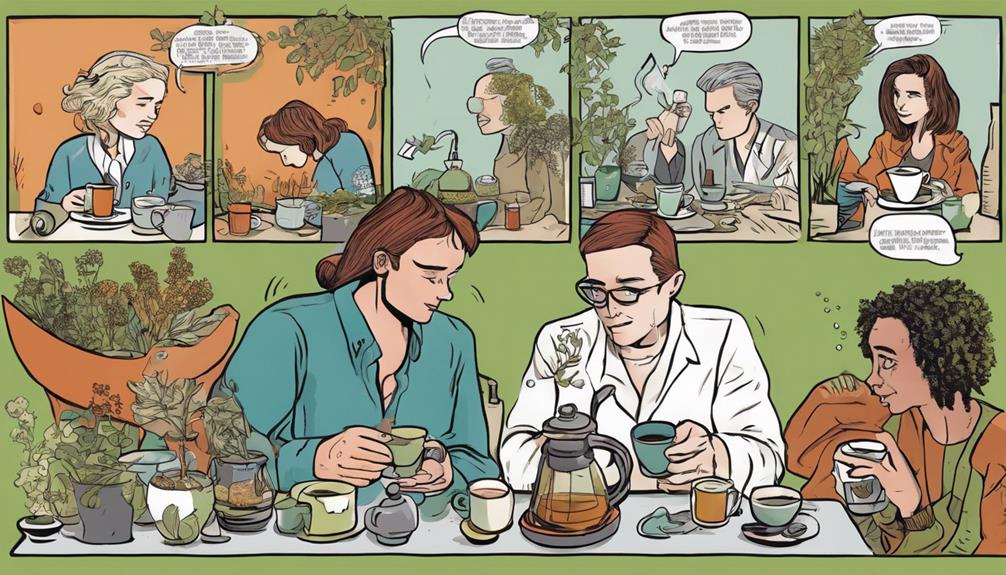
Understanding how individual tolerance factors influence your response to caffeine is essential for managing your overall health and well-being. Various factors, such as body size, genetics, and lifestyle choices, play a significant role in determining how your body reacts to caffeine. For example, lifestyle factors like pregnancy or oral contraceptive use can impact the metabolism of caffeine in your system. Some individuals naturally have a faster caffeine metabolism, which can reduce the negative effects of the substance on their bodies. However, it is crucial to be aware that excessive caffeine consumption can worsen existing heart conditions in certain individuals. By understanding these individual tolerance factors, you can tailor your caffeine consumption to lead a healthier lifestyle.
| Factor | Influence | Example |
|---|---|---|
| Body Size | Larger individuals may need more caffeine to feel its effects, while smaller individuals can be more sensitive to its stimulant properties. | Someone who is tall might require more caffeine to feel awake. |
| Genetics | Genetic variations can impact how efficiently your body metabolizes caffeine, affecting how long it stays in your system and its effects on you. | If your family has a history of fast metabolisms, you might also process caffeine quickly. |
| Lifestyle Choices | Pregnancy, oral contraceptive use, and other lifestyle factors can alter how your body processes caffeine, leading to varying responses to the substance. | Pregnant individuals may need to limit caffeine intake for health reasons. |
Health Risks of Excess Caffeine

Excess caffeine consumption can pose serious health risks to your well-being. It may lead to issues like gastrointestinal discomfort, trouble sleeping, and increased anxiety.
Be mindful of the dangers of overconsumption and prioritize moderation to safeguard your health.
Excessive Caffeine Dangers
Excessive consumption of caffeine poses significant health risks, including gastrointestinal problems, trouble sleeping, and heightened stress levels.
When you overdo it on caffeine, you may experience withdrawal symptoms when you try to cut back. These symptoms can range from severe headaches and difficulty concentrating to irritability.
It's essential to understand the health risks associated with excessive caffeine intake, such as increased heart rate and potential exacerbation of existing heart conditions.
Gradually reducing your caffeine intake is key to avoiding these dangers.
Too much caffeine can't only impact your daily functions and work performance but also affect your overall health and well-being.
Risks of Overconsumption
Consuming too much caffeine can greatly increase the risk of various health problems, including gastrointestinal issues, trouble sleeping, nervousness, anxiety, and an irregular heartbeat.
Overconsumption of caffeine may lead to increased heart rate, high blood pressure, and exacerbation of existing heart conditions. These health risks can interfere with daily functions, impacting productivity and overall well-being.
When you decide to cut back on caffeine intake, be prepared for withdrawal symptoms such as severe headaches, difficulty concentrating, and irritability. It's essential to be mindful of your caffeine consumption and gradually reduce it to avoid these negative health effects.
Health Hazards From Caffeine
When it comes to your health, being mindful of the potential health hazards associated with caffeine consumption is essential. Excessive intake of caffeine can lead to various health issues such as gastrointestinal problems, sleep disturbances, nervousness, anxiety, and irregular heartbeat. These risks can interfere with your daily functions, impacting your overall well-being.
Increased heart rate, restlessness, and exacerbation of existing heart conditions are also linked to consuming too much caffeine. It's important to monitor your caffeine consumption to prevent negative health effects and consider reducing it for a healthier lifestyle.
If you find cutting back on caffeine challenging or experience severe withdrawal symptoms like headaches or fatigue, seeking professional help may be necessary. Understanding the health risks of excess caffeine consumption and taking steps to limit your intake can contribute to better overall health and well-being in the long run.
Strategies for Cutting Back

To start cutting back on caffeine, gradually reduce your intake to avoid withdrawal symptoms.
Keep a caffeine diary to track your sources of caffeine, and remember to stay hydrated and get enough sleep.
Taking these steps can help you manage any discomfort and successfully decrease your caffeine consumption.
Withdrawal Symptoms Management
If you're aiming to reduce your caffeine intake and manage withdrawal symptoms effectively, gradually decreasing your consumption is a recommended strategy. Here are three vital tips to help you navigate through this process:
- Stay Hydrated:
Drinking plenty of water can alleviate some withdrawal symptoms like headaches and fatigue. Hydration supports your body as it adjusts to lower caffeine levels.
- Prioritize Sleep:
Ensuring you get enough quality sleep is pivotal during this period. Adequate rest can help combat the tiredness and irritability often experienced when cutting back on caffeine.
- Practice Self-Care:
Engage in activities that promote relaxation and well-being. Exercise, meditation, or hobbies can distract you from cravings and reduce stress, making it easier to manage withdrawal symptoms.
Tracking Caffeine Intake
Gradually decreasing your caffeine consumption begins with monitoring your daily intake to pinpoint origins and make informed choices on scaling down. Maintaining a caffeine log can be a useful tool in this journey, enabling you to track your consumption from various origins such as coffee, tea, energy drinks, soda, cocoa, and chocolate.
By recognizing these origins, you can gain a better understanding of where your caffeine intake is originating from and progressively lessen your consumption to prevent withdrawal symptoms like headaches and irritability.
When monitoring your caffeine intake, it's crucial to be aware of concealed origins of caffeine in your diet. Keep in mind to stay hydrated and prioritize achieving sufficient sleep as you scale down on caffeine to assist your body through the adjustment.
If you encounter difficulty in reducing your caffeine intake or face persistent withdrawal symptoms, don't hesitate to seek professional assistance for guidance and support in effectively managing this process.
Sources and Reduction of Caffeine

Consider various sources of caffeine in your diet and start by identifying the ones you can reduce or replace with alternatives to gradually decrease your intake.
Here are some steps to help you in this process:
- Switch to Decaf Options: Opt for decaffeinated coffee or tea to enjoy the taste without the caffeine content.
- Limit Energy Drink Consumption: Energy drinks are often packed with caffeine, so try reducing the number of energy drinks you consume or switch to healthier alternatives like herbal teas.
- Check Food Labels: Be mindful of hidden sources of caffeine in food products like chocolate or certain medications. Reading labels can help you make informed choices and cut back on unexpected caffeine intake.
Caffeine Metabolism Insights
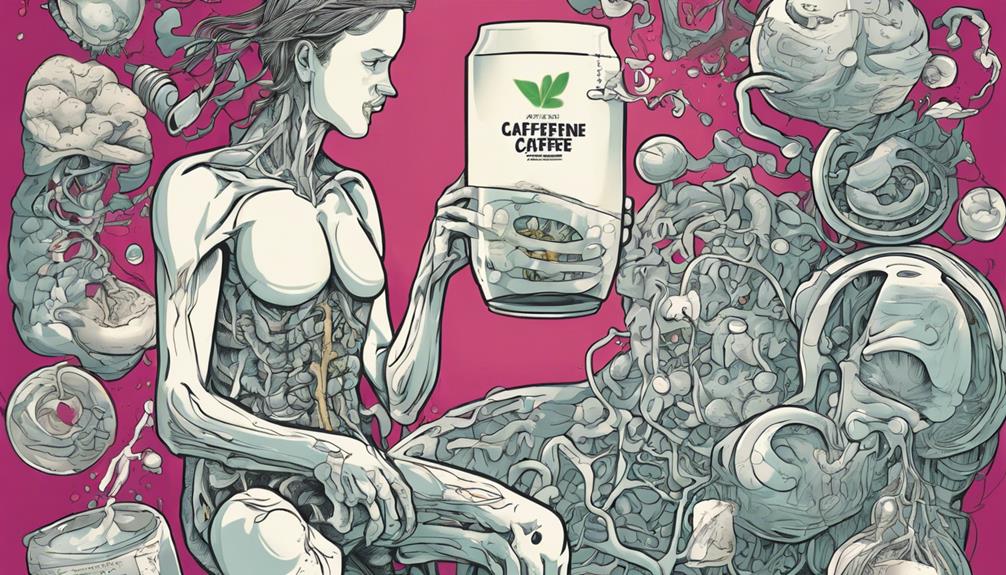
Understanding how your body metabolizes caffeine is essential for making informed choices about your consumption habits and overall health.
Various factors influence caffeine metabolism, with genetic makeup playing a significant role. For instance, some individuals metabolize caffeine quickly, while others do so at a slower rate. This variability can impact how caffeine affects your body and how long it stays active in your system.
The half-life of caffeine, which is the time it takes for half of the caffeine to be eliminated from your body, can vary widely from 1.5 to 9 hours based on individual genetic factors.
To gain a better understanding of caffeine metabolism, it's important to take into account your individual tolerance levels and how they relate to your caffeine consumption. Lifestyle habits such as smoking and medications can also influence how your body processes caffeine.
Risks and Health Effects

To understand the risks and health effects associated with caffeine consumption, it's important to be mindful of the potential negative impacts on your overall well-being.
Here are three key points to keep in mind:
- Excessive caffeine consumption can have detrimental effects on your health, such as gastrointestinal problems, trouble sleeping, nervousness, anxiety, and irregular heartbeat. It's essential to monitor your intake to prevent these issues.
- Withdrawal symptoms from caffeine, such as severe headaches, difficulty concentrating, and irritability, can occur when trying to cut back. Gradually reducing your caffeine intake can help alleviate these unpleasant side effects.
- Pregnant individuals should be especially careful with their caffeine consumption, limiting it to less than 200 milligrams per day to reduce risks to both themselves and their unborn child.
Additionally, heavy consumption of caffeine from energy drinks has been linked to anxiety and unsafe behaviors, particularly concerning in adolescents due to the potential health risks associated with excessive caffeine intake.
Weight Management Tips

Boost your weight management efforts with these practical tips for managing your coffee consumption. When it comes to weight management, caffeine can be a helpful tool. It can increase your metabolism and reduce your appetite, aiding in your weight loss journey.
Opting for black coffee is a smart choice as it has minimal calories, unlike creamy and sugary coffee options that can contribute to weight gain. Remember, moderation is key. Consuming caffeine in reasonable amounts can help control your weight by boosting your energy expenditure.
Be cautious of high-calorie coffee drinks like lattes and mochas, as they can sabotage your weight management efforts. Choosing unsweetened alternatives and keeping an eye on your overall calorie intake from coffee beverages can make a significant difference in your weight control goals.
Make informed choices when it comes to your caffeine consumption to support your weight management journey effectively.
Special Considerations for Intake

Consider moderating your caffeine intake with these special considerations in mind.
When it comes to managing your caffeine intake, there are a few important factors to keep in check:
- Limit Your Cups Per Day: If you're pregnant, it's important to restrict your caffeine consumption to less than 200 milligrams per day. This can help reduce potential risks and ensure a healthier pregnancy.
- Beware of Withdrawal Symptoms: When shifting to decaffeinated beverages, be aware that withdrawal symptoms may occur. To alleviate these symptoms, consider gradually adjusting your intake to make the shift smoother.
- Monitor Decaffeinated Beverages: Although decaffeinated coffee is a popular alternative, it still contains varying amounts of caffeine, ranging from 2 to 15 milligrams. It's vital to carefully monitor your consumption to stay within your desired caffeine limits.
Lifestyle Changes for Health

Gradually reducing your coffee intake can lead to positive lifestyle changes for improved health and well-being. As you start on this journey to lower your caffeine consumption, it's crucial to recognize that you may experience withdrawal symptoms like headaches and irritability.
However, by implementing strategic lifestyle adjustments, you can alleviate these effects and shift smoothly. Cutting back on coffee not only improves sleep quality and reduces anxiety levels but also opens up opportunities to try alternative beverages such as herbal teas or decaffeinated options.
Increasing your water intake and participating in regular physical activity can help counteract the initial impact of caffeine withdrawal, aiding in feeling more invigorated and balanced. Embracing new morning rituals and integrating relaxation practices into your daily routine can further bolster this transition away from coffee consumption.
Frequently Asked Questions
What Is a Healthier Alternative to Coffee?
Looking to switch it up from coffee? Try green tea for a moderate caffeine boost or herbal teas like chamomile for a soothing brew. Matcha powder offers sustained energy, while golden milk provides a caffeine-free, anti-inflammatory option.
Does Quitting Coffee Improve Health?
Giving up coffee can boost your health. Improved sleep, regulated blood pressure, decreased risk of GI issues, and better hydration are benefits. You'll feel less anxious, have fewer heart palpitations, and reduce caffeine reliance.
Is It Healthy to Cut Out Caffeine?
Cutting out caffeine can improve sleep, reduce anxiety, regulate blood pressure, enhance hydration, stabilize energy, balance hormones, and reduce stimulant reliance. It's a healthy choice for overall well-being and avoiding potential health issues.
How Do You Wean off Caffeine Safely?
To wean off caffeine safely, gradually decrease intake, track consumption, switch to decaf or herbal teas, stay hydrated, and guarantee enough rest. Seek professional help if needed. Managing withdrawal symptoms like headaches and irritability is key.
Conclusion
Take control of your caffeine intake to improve your overall health and well-being. By implementing strategies to cut back on coffee and other sources of caffeine, you can reduce your risk of negative health effects and manage your weight more effectively.
Remember, moderation is key when it comes to caffeine consumption. So, grab a glass of water instead of that third cup of coffee and watch your health bloom like a flower in a caffeine-free garden.
Tips and Tricks
Dental Care: How to Brush After Coffee to Avoid Stains!
Avoid coffee stains on your teeth with this simple trick: brush after your morning cup to keep your smile bright!
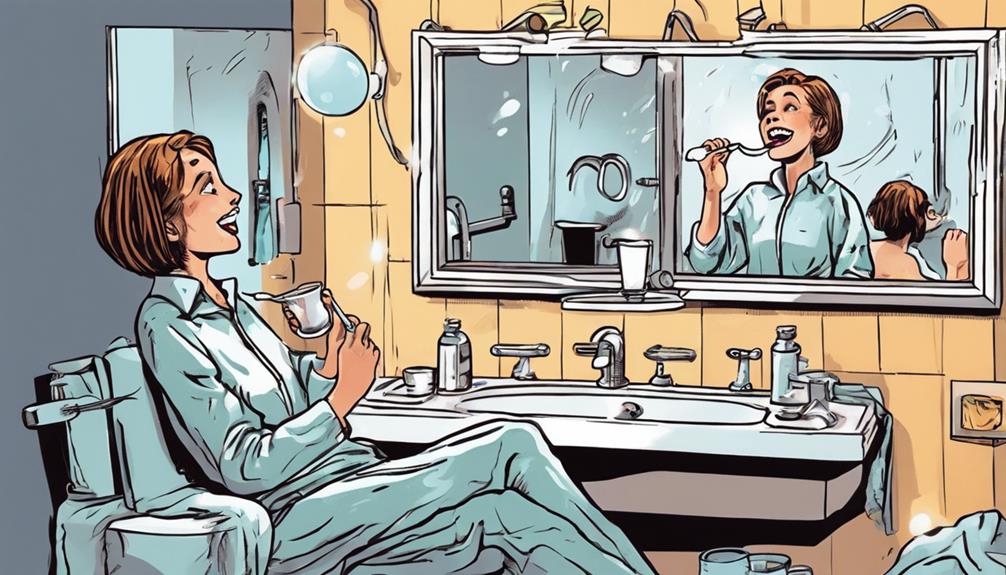
To avoid getting coffee stains on your teeth, make sure to brush after your morning cup. Adding milk to your coffee can help lighten the color and protect your smile. Using a straw when drinking coffee can also help reduce direct contact with your teeth, especially the front ones. Opt for decaf or lower-caffeine options to lower the risk of discoloration. Consider professional whitening treatment for stubborn stains. It’s ideal to brush after coffee for the best results in preventing stains. More tips are available to help you maintain a bright, coffee stain-free smile. Using a whitening toothpaste can also assist in keeping your smile bright. Drinking water after coffee can help wash away any leftover residue. If you prefer your coffee sweet, try using a sugar substitute to lessen the likelihood of tooth stains. Lastly, consuming a small amount of dark chocolate can enhance chocolate notes in your coffee while reducing the chance of teeth staining.
Key Takeaways
- Brush immediately after coffee to prevent stains from setting.
- Use fluoride toothpaste for effective stain removal.
- Consider a whitening toothpaste for daily maintenance.
- Rinse with water after coffee to reduce staining.
- Regular dental cleanings help combat coffee stains.
Coffee Stains on Teeth
If you want to prevent coffee stains on your teeth, brushing after your morning coffee is essential. Coffee drinkers often find themselves battling the stubborn stains that this beloved beverage can leave behind. The yellowing of teeth over time is a common issue faced by regular coffee consumers.
While the immediate effects may not be visible after just one cup, the front teeth are particularly vulnerable due to direct contact with the coffee. This makes prevention imperative to maintaining a bright smile.
Brushing your teeth after you drink coffee can help remove the residue before it has a chance to stain your teeth. Implementing this simple habit into your morning routine can go a long way in preserving the whiteness of your teeth.
Additionally, using methods like drinking through a straw can also aid in preventing coffee stains on your teeth. By taking these proactive steps, you can enjoy your coffee without worrying about its effects on your smile.
Adding Milk for Protection

Consider incorporating milk into your coffee as a simple way to protect your teeth from the discoloration caused by coffee stains. Adding milk, especially animal milk rich in protein, can help lighten the color of your coffee and reduce the risk of staining on your teeth.
The protein in milk binds with the polyphenols present in coffee, which are responsible for the staining effect, thereby decreasing their ability to discolor your teeth. Additionally, milk with higher fat content can offer better protection against coffee stains on your teeth.
Changing Drinking Habits
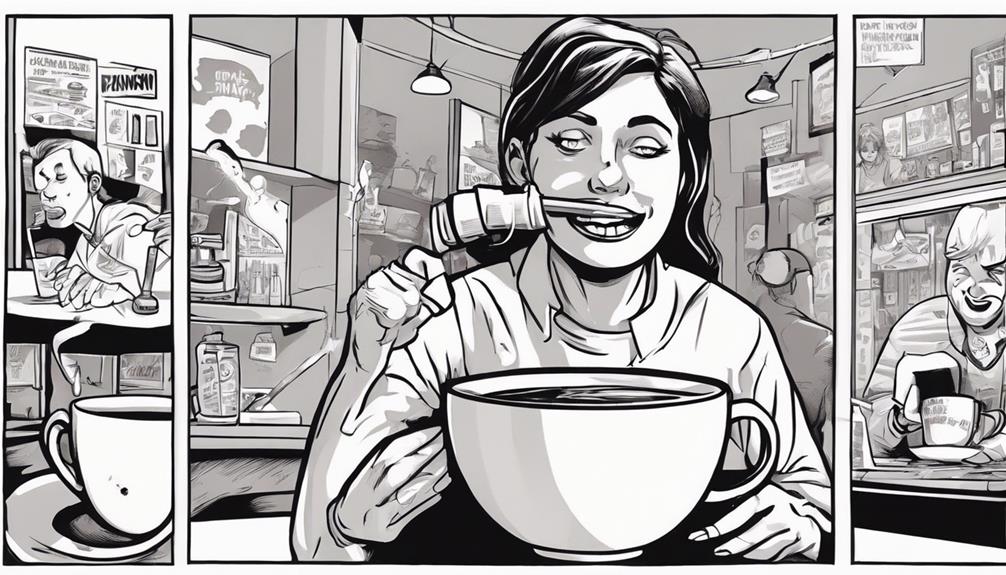
To prevent coffee stains on your teeth, consider changing your drinking habits. Using a straw can help minimize direct contact with your teeth, reducing the risk of staining.
Opting for a cup or thermos to drink coffee is another effective technique to prevent stains on your teeth.
Straw for Coffee
Drinking coffee through a straw offers a simple yet effective way to reduce the likelihood of staining your teeth. By using a straw for coffee, you can prevent direct contact between the staining polyphenols in the coffee and your teeth. These polyphenols are known for causing yellow and brown stains, which are less likely to adhere to your teeth when you sip through a straw.
Additionally, front teeth are particularly vulnerable to coffee stains, making the use of a straw a practical solution to avoid coffee stains in these prominent areas. Unlike drinking from a cup or thermos, where coffee can easily wash over your teeth and potentially lead to stains, using a straw directs the coffee away from your teeth.
While using a straw for coffee may seem unconventional, it's a highly effective method to prevent those pesky coffee stains from tarnishing your smile.
Stain Prevention Techniques
Switching up your beverage consumption method can play a vital role in preventing coffee stains on your teeth. Drinking coffee through a straw is a simple yet effective way to prevent direct contact between the staining polyphenols in coffee and your teeth.
These polyphenols are more likely to affect the front teeth, making prevention essential for maintaining a bright smile. While using a cup or thermos to drink coffee may seem convenient, it can actually increase the risk of stains as the liquid washes over your teeth.
Opting for a straw may feel unconventional, but it's highly efficient in safeguarding your teeth against discoloration.
Managing Caffeine Intake

Considering the impact of caffeine levels in coffee on teeth staining, managing your intake can be essential in maintaining a bright smile. Higher caffeine content in coffee is linked to more severe teeth stains, so choosing decaf or lower-caffeine options can help reduce the risk of discoloration.
The polyphenols present in coffee, which are closely related to caffeine levels, play a significant role in teeth staining. By being mindful of your caffeine intake, you can better protect your oral hygiene and prevent coffee stains on your teeth.
Additionally, varying brewing methods can influence how likely coffee is to cause staining, so experimenting with different preparation techniques may also be beneficial. Remember to brush your teeth after consuming coffee to remove any lingering particles and reduce the chances of stains from caffeine affecting your smile.
Managing your caffeine intake is a proactive step towards maintaining a white and healthy smile.
Professional Whitening Benefits

For best results in achieving a brighter smile, professional whitening treatments offer superior effectiveness in removing stubborn coffee stains compared to at-home kits. These treatments not only remove existing stains but also help prevent new ones from forming. Regular sessions of professional whitening can maintain a white smile and provide long-lasting protection against coffee stains on teeth. Consulting a dentist or orthodontist for professional whitening options is recommended to ensure optimal results. By combining professional whitening with other preventive methods, such as reducing caffeine intake and proper oral hygiene practices, you can establish the best defense against coffee-induced teeth discoloration.
| Benefits of Professional Whitening |
|---|
| Removes stubborn coffee stains effectively |
| Prevents new stains from forming |
| Provides long-lasting protection |
| Ensures optimal results with professional guidance |
| Combines with preventive measures for best defense |
Best Time to Brush After Coffee

When considering the best time to brush after coffee, timing is essential for maintaining healthy teeth and preventing stains.
Waiting at least 30 minutes after your coffee can help protect your enamel from the acidity of the beverage.
Brushing Timing Recommendations
To maintain ideal oral health and prevent staining, it's recommended to wait at least 30 minutes after rinsing before brushing your teeth following coffee consumption. Brushing immediately after coffee can be harmful due to the high acidity weakening the enamel.
By waiting, you allow your saliva to neutralize the acid and remineralize the enamel, reducing the risk of enamel erosion. Cleaning your teeth before coffee can create a protective barrier, making it more challenging for stains to adhere to the enamel.
Rinsing your mouth with water after coffee helps remove residue and further protects the enamel. Remember, the enamel is at its weakest state after exposure to acidic substances like coffee; hence, delaying brushing is essential to enamel protection.
Stain Prevention Strategies
Consider brushing after your morning coffee as an essential move to prevent stains on your teeth. Stain prevention starts with brushing before coffee, creating a protective barrier that makes it harder for stains to adhere to your enamel.
After enjoying your cup of coffee, rinse your mouth with water to remove any residue and safeguard your enamel. It's pivotal to wait at least 30 minutes before brushing your teeth to prevent enamel damage, as brushing immediately after coffee, when acidity levels are high, can weaken the enamel further.
Remember that good oral hygiene practices such as regular brushing, flossing, and rinsing play a significant role in preventing coffee stains on your teeth. By incorporating these stain prevention strategies into your routine, you can enjoy your morning coffee without worrying about its effects on your smile.
Frequently Asked Questions
How to Stop Coffee From Staining Your Teeth?
To stop coffee from staining your teeth, try adding milk, using a straw, brushing or rinsing after coffee, and alternating sips with water. These simple steps can help prevent those pesky coffee stains from setting in!
Does Brushing Teeth After Coffee Help With Stains?
Brushing teeth immediately after coffee won't help with stains. Instead, wait 30 minutes to protect enamel. Rinse with water post-coffee to remove residue. Remember, coffee's acidity can soften enamel, so timing is key for a brighter smile. If you’re a regular coffee drinker, consider using a straw to minimize contact with your teeth. Another option is to switch to iced coffee, which is generally less damaging to enamel. And if you’re looking to enjoy the aroma of coffee without the dental drawbacks, consider burning coffee beans for scent instead.
How to Get Caffeine Without Staining Teeth?
To get caffeine without staining teeth, try adding milk to coffee or using a straw. Brush teeth after drinking, rinse with water, and alternate with sips of water. Protect your enamel and reduce risks of stains.
How to Take Care of Teeth After Coffee?
After coffee, wait 30 minutes before brushing to protect enamel. Rinse with water to remove residue. Using a straw or adding milk can help prevent staining. Brushing immediately after or swishing with water can also help. If you prefer to freshen your breath after drinking coffee, consider using a mouthwash with a pleasant coffee bean scent. This can help neutralize any coffee odor and leave your mouth feeling clean and refreshed. Additionally, consider carrying a travel-sized toothbrush and toothpaste to use after your coffee break for a thorough cleaning routine.
Conclusion
So there you have it – to avoid coffee stains on your teeth, make sure to brush after your morning cup of joe.
Adding milk to your coffee and managing your caffeine intake can also help protect your pearly whites.
Don't forget the benefits of professional whitening if stains become a problem.
Remember, the best time to brush after coffee is within 30 minutes to prevent staining.
Keep those teeth bright and healthy!
Tips and Tricks
Sweet Perfection: How to Bring Out Sweetness in Coffee!
Leverage natural and artificial sweeteners to enhance your coffee's sweetness and explore techniques for a perfectly sweet brew!
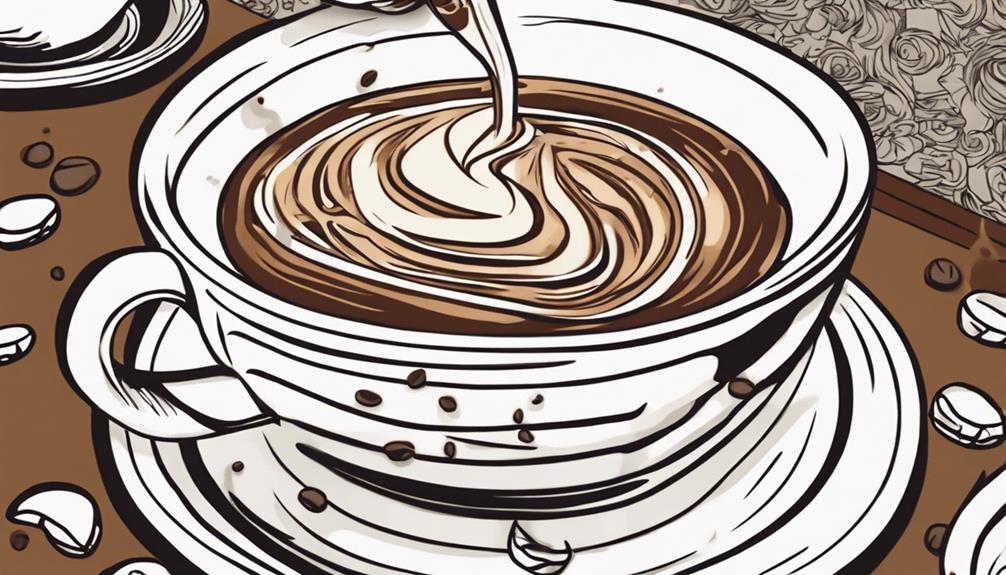
To enhance the sweetness of your coffee, consider using natural options such as honey, cinnamon, or vanilla extract. Artificial sweeteners like stevia or sucralose can also help improve the flavor. Experiment with low-calorie methods to customize the sweetness without adding extra calories. It is important to consider the health implications and adjust the roast profiles to enhance the sweetness. Refine the sweetness using a refractometer for accurate measurements and try different pouring techniques for optimal taste. By exploring various combinations and flavor pairings, you can elevate your coffee experience. Mastering these methods can uncover the perfect sweetness in your brew.
Key Takeaways
- Experiment with natural sweeteners like honey and cinnamon to enhance coffee sweetness.
- Consider using a refractometer to measure Total Dissolved Solids for optimal sweetness.
- Explore different brewing methods like pour-over or French press for varied sweetness profiles.
- Adjust roast profiles to balance acidity and sweetness in coffee beans.
- Pair coffee with complementary flavors like vanilla or almond milk for a sweeter taste.
Natural Sweetening Options
To naturally sweeten your coffee, consider using honey, agave, or unsweetened cocoa powder. These natural sweeteners can enhance the flavor of your coffee without the need for refined sugars. Each of these options brings a unique sweetness that can help you find the perfect balance of sweetness in your cup of joe.
Natural sweeteners like coconut sugar, date sugar, and maple syrup offer alternatives to traditional white sugar, allowing you to customize the sweetness level of your coffee to suit your taste preferences. Additionally, stevia and monk fruit are excellent choices for those looking to add sweetness without the calories associated with sugar.
Spices such as cinnamon and vanilla extract can also contribute to the natural sweetness of your coffee, providing a flavorful twist without the need for additional sweeteners.
Artificial Sweeteners for Coffee

Consider artificial sweeteners like stevia, sucralose, aspartame, and saccharin as calorie-free options to sweeten your coffee while avoiding the use of sugar. These artificial sweeteners provide a customizable level of sweetness to your coffee without the added calories that come with sugar. While they are popular choices for those looking to cut down on sugar intake, it is essential to be aware of potential health risks associated with these sweeteners. Understanding the side effects and implications of artificial sweeteners can help you make informed decisions about your coffee sweetening choices.
—
| Artificial Sweetener | Sweetness Level | Health Risks |
|---|---|---|
| Stevia | High | Minimal |
| Sucralose | Very High | Some studies suggest potential risks |
| Aspartame | Moderate | Controversial studies on health effects |
| Saccharin | Low | Previously linked to cancer, but considered safe in moderate amounts |
Low-Calorie Sweetening Techniques

Low-calorie sweetening techniques such as using artificial sweeteners offer a way to customize the sweetness of your coffee without adding extra calories. Instead of relying on raw sugar, which can increase the calorie content of your cup of joe, consider incorporating sweeteners like stevia, sucralose, or aspartame. These options provide the desired sweetness without the added calories, making them ideal for those looking to maintain a low-calorie diet while still enjoying a flavorful coffee experience.
When choosing a sweetener for your dark roast coffee, be mindful of the balance between sweetness and flavor. Experiment with different types of artificial sweeteners to find the one that complements the richness of your coffee without overpowering it.
Sweetening Experimentation Tips

To bring out the best sweetness in your coffee, consider experimenting with flavor pairings and different sweeteners. By exploring various combinations, you can discover unique ways to enhance the taste of your brew. Some popular flavor pairings with coffee include vanilla, caramel, and cinnamon. You can also try using different natural coffee sweeteners such as honey, maple syrup, or agave nectar. These options can add a subtle sweetness to your coffee without overwhelming the flavor of the beans. Experimenting with flavor pairings and natural coffee sweeteners can help you customize your coffee to your liking and make each cup a delightful experience.
Keep an open mind and be willing to try new techniques to find the perfect balance of flavors.
Flavor Pairing Tips
Experiment with various flavor pairings like cinnamon, vanilla, or honey to naturally enhance the sweetness of your coffee. These flavor pairing tips can elevate the natural sweetness of your brew without the need for added sugars.
Additionally, incorporating unsweetened almond milk or coconut milk can provide extra sweetness without the calories.
When exploring flavor pairings, consider trying different roast profiles and blends to bring out the inherent sweetness in your coffee. Adjusting roast profiles can help highlight the coffee sweetness and balance the overall flavors.
Infusing flavors like cinnamon or vanilla can also contribute to a sweeter taste profile.
Sweetener Selection Guide
Enhance your coffee's sweetness naturally by exploring a range of sweetener options beyond traditional sugar. Experiment with natural sweeteners like honey, maple syrup, or agave to bring out the innate sweetness of coffee without compromising on flavor notes. These alternatives add a delightful touch without the excess calories.
For a sugar-free option, consider using stevia, monk fruit, or erythritol. These low-calorie artificial sweeteners provide a guilt-free way to enjoy your coffee.
If you prefer flavored sweeteners, sugar-free syrups in varieties like vanilla or caramel offer a customizable and gourmet experience. Additionally, adding a dash of cinnamon or a sprinkle of cocoa powder can enhance the sweetness and introduce unique flavor profiles to your coffee.
For a creamy texture and natural sweetness, try using unsweetened almond milk or coconut milk as dairy alternatives. By choosing the right sweetener, you can elevate the sweetness of your coffee while exploring different taste dimensions.
Health Considerations With Sweeteners
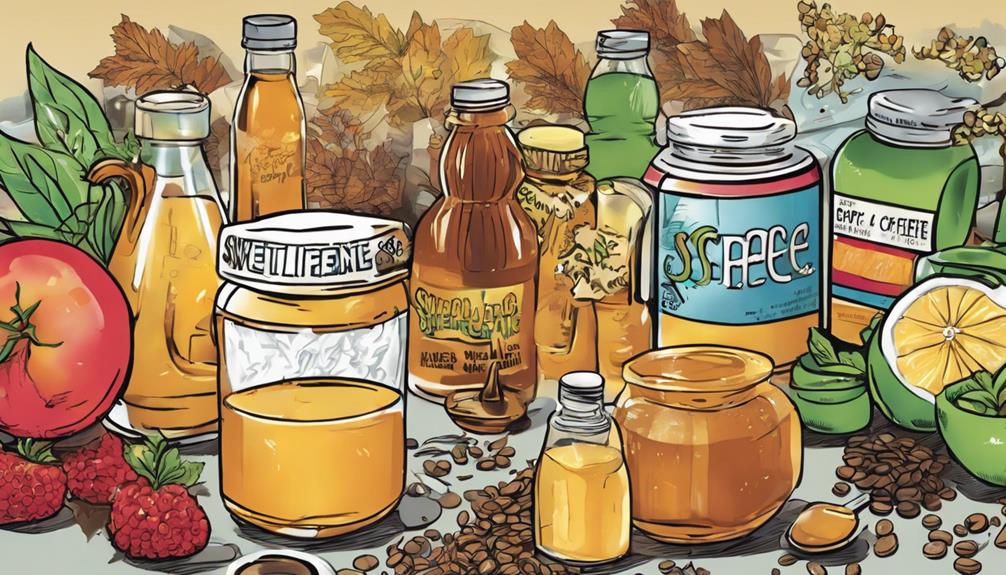
Consider the potential health risks associated with artificial sweeteners when sweetening your coffee. Artificial sweeteners like aspartame and saccharin have been linked to health risks such as cancer and metabolic disorders. Consuming these sweeteners in coffee could disrupt gut bacteria and lead to glucose intolerance.
On the other hand, natural sweeteners like Stevia provide a low-calorie alternative, but some individuals may find its bitter aftertaste off-putting. Be cautious with low-calorie sweeteners as they may impact appetite regulation and increase sugar cravings.
Popular Natural Sweetener Choices

Honey and agave are among the popular natural sweeteners commonly used to add a touch of sweetness to your coffee. Honey offers a sweet, floral, and sticky taste that complements coffee well, while agave, sweeter than sugar and similar to honey, provides a flavorful alternative for sweetening your brew.
If you're looking to enhance the natural sweetness of your coffee without adding sugar, consider using unsweetened cocoa powder. Another option is coconut sugar, which has a lower glycemic index than white sugar, making it a healthier choice for sweetening your coffee.
For a unique twist, try date sugar with its slightly floral and caramelized taste to add a distinct sweetness to your morning cup. Experiment with these popular natural sweeteners to find the perfect complement for your coffee and satisfy your sweet cravings without compromising on flavor.
Factors Affecting Coffee Sweetness
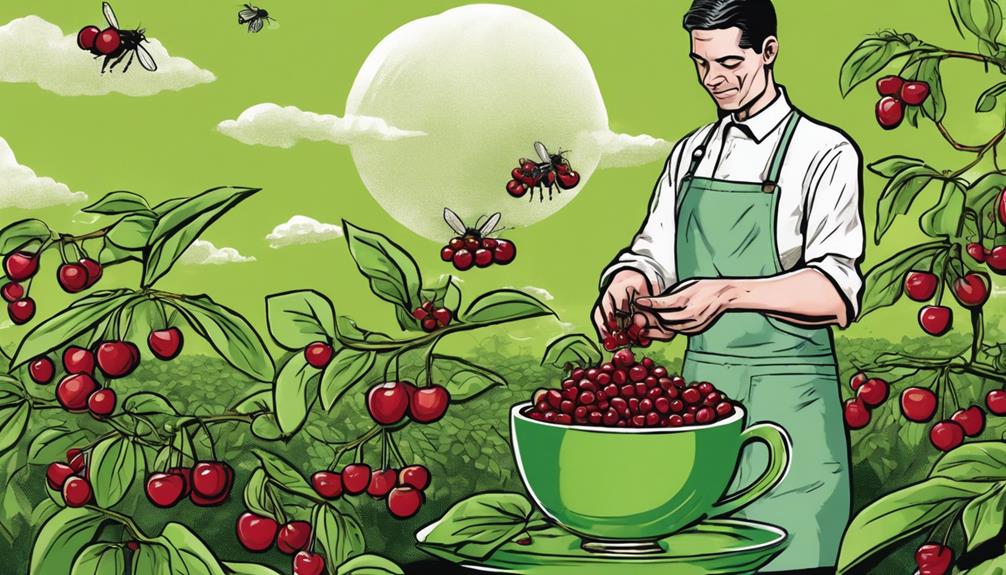
Various factors such as bean quality, roast level, water quality, and brewing temperature greatly impact the sweetness of your coffee.
When it comes to sweetness in coffee, the following factors can play a significant role:
- Coffee Beans: The origin of the coffee beans, their elevation, and the ripeness of the coffee fruit all contribute to the natural sweetness present in your brew.
- Roast Level: Adjusting the roast level can affect the sweetness of your coffee, with lighter roasts often preserving more of the beans' inherent sweetness.
- Brewing Techniques: Factors like grind size, extraction time, and water type used during brewing can influence how sweet your coffee tastes.
- Quality Considerations: Enhancing sweetness in coffee involves using beans from specific regions known for producing sweeter profiles, alongside precise brewing methods to extract those flavors effectively.
Brewing Techniques for Sweet Coffee
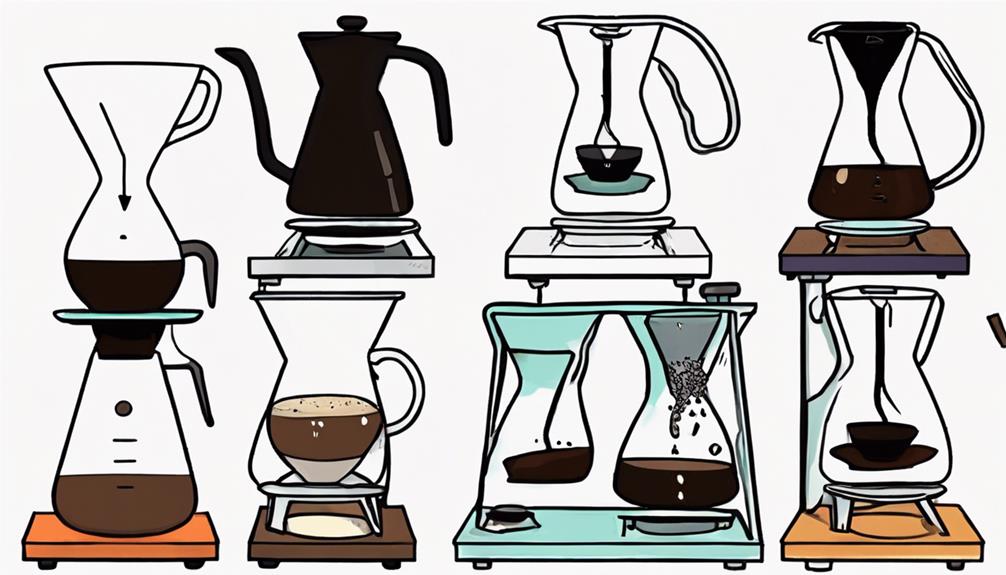
To boost the sweetness of your coffee, focus on refining your brewing techniques for the best flavor extraction.
Pre-warm your brewing equipment before starting to ensure ideal extraction and sweetness in your cup of coffee.
Experiment with different grind sizes to find the perfect balance that brings out the coffee's sweetness.
Accurately measure your coffee and water ratios to consistently achieve the desired level of sweetness in your brew.
Consider using a refractometer for precise measurements, helping you fine-tune the sweetness of your coffee to perfection.
Additionally, explore various pouring methods as they can greatly enhance the sweetness and overall flavor profile of your brewed coffee.
Frequently Asked Questions
How Do You Bring Out the Sweetness in Coffee?
To bring out the sweetness in coffee, experiment with different brewing methods, consider the bean origin and roast level, use high-quality water, and explore natural sweeteners like honey. Look for reputable roasters focusing on sweet and balanced coffees.
What Can I Add to My Coffee to Make It Sweeter?
To make your coffee sweeter, try adding natural sweeteners like honey or agave, flavored syrups like vanilla, or unsweetened almond milk. Sprinkle in cinnamon or cocoa powder, or use sugar-free sweeteners like stevia for a guilt-free treat.
How to Extract Sweeter Coffee?
To extract sweeter coffee, adjust brewing temp and time, use high-quality beans, try various methods like pour-over, and consider bean origin and roast. Focus on grind size and water quality for max sweetness extraction.
How to Increase Coffee Sweetness?
To increase coffee sweetness, try adjusting roast profiles, using high-quality beans, experimenting with brewing methods and water temperatures, and adding sweetening agents like honey or cinnamon. Lighter roasts can also bring out fruity or floral notes.
Conclusion
So there you have it – sweetening your coffee doesn't have to be complicated. Just remember to experiment with different sweeteners, brewing techniques, and flavors to find your perfect cup of sweet perfection. If you’re looking to reduce your sugar intake, there are plenty of options for how to enjoy coffee without sugar. You can try adding a splash of vanilla or almond milk for a touch of sweetness without the added sugar. Another option is to experiment with different roasts and blends to find a coffee that naturally has flavor notes that you enjoy, without the need for added sugar. And don’t forget to savor the experience – take the time to truly appreciate the complexities of your coffee, and you may find that you don’t even miss the sugar.
Like a barista crafting a masterpiece, you can bring out the sweetness in your coffee with a little creativity and a lot of love. By experimenting with different brewing methods and adding a sprinkle of cinnamon or a touch of vanilla, you can create a delicious and personalized cup of coffee. And if you’re looking to beat coffee cravings, try substituting your usual cream and sugar with healthier alternatives like almond milk and a dash of honey for a guilt-free and satisfying treat. With a little effort and imagination, you can elevate your coffee experience and savor every sip.
So go ahead, sweeten up your mornings and savor every sip of your personalized coffee creation.
Tips and Tricks
Taste Boost: How to Bring Out Flavor in Coffee!
Boost your coffee's flavor with warm spices, frothy milk, and surprising twists for a sensory journey you won't want to miss!
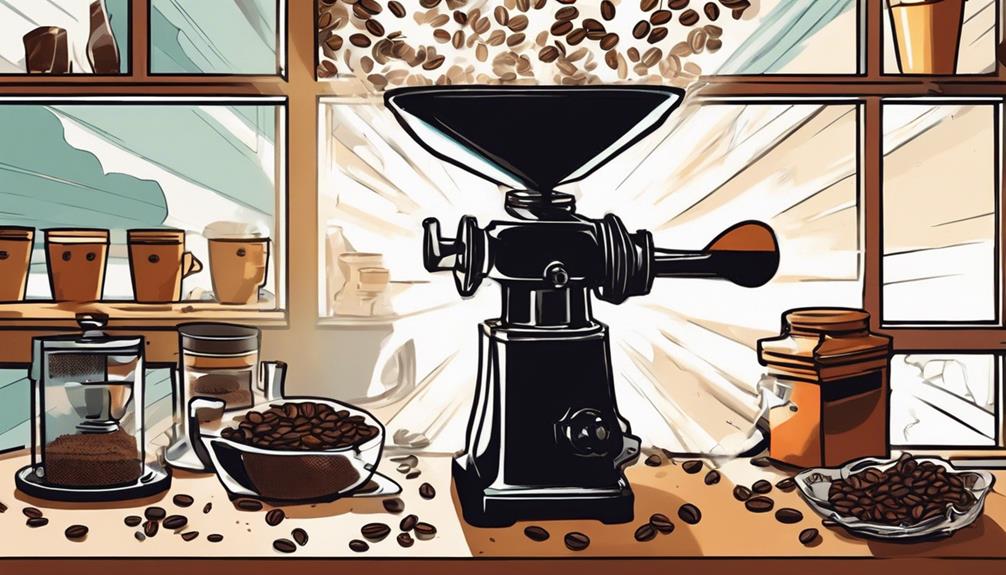
Improve the flavor of your coffee by incorporating warm baking spices like cinnamon and nutmeg for a comforting scent and indulgent taste. Experiment with various spice blends to create unique flavors that enhance your brew. Froth your milk perfectly to achieve a creamy texture, adding a touch of richness. Consider trying non-dairy options such as almond or oat milk for a different taste experience. Adding a pinch of salt to your coffee grounds can help reduce bitterness, resulting in a smoother flavor profile. To enhance the coffee’s taste, try infusing it with citrus zest to complement chocolate undertones. These simple techniques will turn your everyday cup of coffee into a delightful sensory journey. For an even better experience, check out natural ways to boost energy in your coffee. A hint of cayenne pepper can provide a subtle kick and a natural energy boost, while a bit of honey or maple syrup can add sweetness without artificial sweeteners. These natural enhancements can elevate your morning coffee, offering both flavor and energy to kickstart your day. For a more decadent treat, try adding a splash of vanilla extract or a sprinkle of cocoa powder to your coffee. These natural flavors can elevate your coffee to a gourmet level. Furthermore, incorporating a brisk walk or quick workout into your morning routine can help combat coffee withdrawal symptoms by providing a natural energy boost to complement your rejuvenating cup of coffee.
Key Takeaways
- Experiment with warm baking spices like cinnamon or nutmeg for enhanced flavor.
- Froth milk for a creamy texture and richness in coffee.
- Create specialty drinks like mochas with hot chocolate powder.
- Balance bitterness by adding a pinch of salt to coffee grounds.
- Infuse coffee with citrus zest for a revitalizing twist.
Enhancing Coffee With Spices
To bring out a richer and more aromatic flavor in your coffee, consider enhancing it with spices. Adding warm baking spices like cinnamon, nutmeg, star anise, cloves, or cardamom to your coffee grounds before brewing can elevate your coffee experience.
Just a pinch or two of ground spice stirred in can create a cozy and inviting aroma that enhances the overall taste.
Experimenting with different spice combinations allows you to develop unique flavor profiles in your coffee, tailoring it to your preferences. The addition of spices not only adds warmth and richness to your cup but also transforms it into a flavorful and aromatic treat.
By incorporating spices into your brewing process, you can enjoy a delightful sensory experience that takes your coffee to the next level.
Next time you brew a cup of coffee, consider reaching for your spice rack to add an extra layer of depth and complexity to your favorite beverage.
Elevating Coffee With Frothy Milk
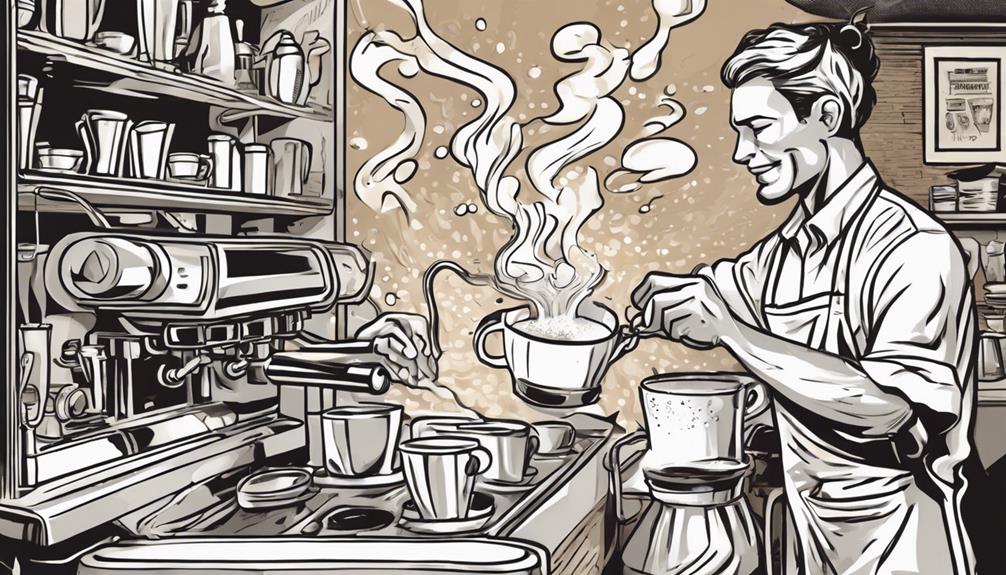
Enhance your coffee experience by elevating it with frothy milk, creating a luxurious and velvety texture that adds a touch of sophistication to your cup.
Frothy milk can transform your regular coffee into a delightful treat reminiscent of a specialty drink from a café. Here's how to achieve this at home:
- Froth to Perfection: Froth your milk in a sealed container until it's silky and has a layer of foam on top, ready to be poured into your coffee.
- Velvety Texture: Watch as the frothy milk cascades into your cup, adding a creamy richness and a luxurious mouthfeel to your coffee.
- Non-Dairy Alternatives: Explore options like almond, oat, or soy milk, which can also be frothed to create a creamy and frothy texture for your coffee.
- Barista-Approved Technique: Impress yourself with the professional touch of frothy milk, elevating your coffee experience without leaving the comfort of your home.
Elevate your coffee game with frothy milk, turning your daily brew into a decadent indulgence.
Transforming Coffee Into a Mocha

To transform your coffee into a tasty mocha, simply mix in hot chocolate powder with sugar and milk powder.
This easy hack can help elevate the flavor of your coffee, providing a sweet and indulgent treat.
Enjoy a delicious homemade mocha without the need for any fancy equipment or hard-to-find ingredients.
Sweetening With Cocoa Mix
Consider transforming your regular coffee into a delectable mocha treat by simply stirring in some hot chocolate mix. Hot chocolate mix can make your coffee taste better by adding a touch of sweetness and richness.
Here's how you can easily make a delightful mocha at home:
- Sprinkle: Sprinkle a packet of hot chocolate mix into your brewed coffee.
- Stir: Stir vigorously to make sure the cocoa mix blends well with the coffee.
- Taste: Take a sip and adjust the sweetness by adding more mix if desired.
- Enjoy: Indulge in your homemade mocha without the need for any fancy equipment or barista skills.
Homemade Mocha Recipe
Transform your ordinary coffee into a delightful mocha treat by following this simple homemade recipe that includes stirring in hot chocolate mix.
Begin by brewing a fresh cup of coffee to your liking. Next, add a tablespoon of brown sugar to the coffee and stir until dissolved.
Then, scoop in a packet of hot chocolate mix, ensuring it blends well with the coffee. The hot chocolate mix, typically containing sugar and milk powder, not only sweetens your drink but also helps mask any bitterness in the coffee, leaving you with a rich and decadent mocha flavor.
This quick and easy method allows you to enjoy the luxuriously creamy taste of a mocha without the need for any fancy equipment or extra steps.
Treat yourself to a homemade mocha today and savor the delicious combination of coffee and cocoa in every sip!
Balancing Bitterness With Salt

To bring out the best flavors in your coffee, consider balancing bitterness with salt. By adding just a pinch of salt to your coffee grounds before brewing, you can reduce the harshness and create a smoother taste.
Experiment with this simple trick to find the perfect balance and elevate your coffee experience.
Salt to Reduce Bitterness
By adding a small amount of salt to your coffee grounds before brewing, you can effectively reduce bitterness and enhance the overall flavor profile of your brew. Here's how salt can help balance the bitterness in your coffee:
- Cutting Through Bitterness:
Salt acts as a flavor enhancer, helping to offset and cut through the bitter notes that can sometimes overpower coffee made from certain beans.
- Creating a Smoother Taste:
When added in the right amount, salt can work wonders in smoothing out the harshness often associated with bitter coffee.
- Finding Your Perfect Balance:
Experiment by sprinkling a pinch of salt into your coffee grounds to find the ideal balance that suits your taste buds.
- Enhancing Flavor:
Just a hint of salt can elevate the overall flavor profile of your coffee by reducing the sharpness and allowing other flavors to shine through.
Discover how this simple trick with salt can transform your coffee experience, making each sip more enjoyable and flavorful.
Enhancing Smoothness With Salt
Enhancing smoothness with salt in your coffee grounds can effectively balance out bitterness, resulting in a more enjoyable drinking experience.
Simply add a small amount of salt to your coffee grounds before brewing to enhance the taste and create a smoother flavor profile.
The salt acts as a flavor enhancer, cutting through the sharpness and acidity of the coffee, ultimately leading to a more well-rounded taste.
Experiment with different quantities of salt to find the perfect balance that suits your taste preferences.
By infusing your coffee with a hint of salt, you can improve the overall smoothness without altering its core flavor.
This simple and effective method allows you to enjoy a more pleasurable coffee experience.
Balancing Acidity With Salt
When looking to balance the acidity in your coffee and reduce bitterness, consider incorporating a small amount of salt into your coffee grounds before brewing. Here's how salt can help you achieve a harmonious flavor profile:
- Enhanced Grinding Process: Salt can be added directly to the coffee beans before grinding, allowing it to infuse with the grounds and distribute evenly for a balanced taste.
- Pleasing Taste Buds: The addition of salt can stimulate your taste buds in a way that complements the natural flavors of the coffee, making it more enjoyable.
- Personalized Balance: Experimenting with different salt quantities enables you to tailor the bitterness level to your liking, creating a customized brew.
- Simple Flavor Adjustment: Salt acts as a simple yet effective tool to cut through the acidity, resulting in a smoother and richer coffee experience.
Infusing Coffee With Citrus Zest

To infuse your coffee with an invigorating twist, consider adding citrus zest to your brew. Citrus zest, whether from an orange or grapefruit, can enhance the flavor of your coffee by adding a revitalizing twist. This addition complements the chocolate notes in your coffee, creating a harmonious blend of citrus and chocolate flavors.
For a unique infusion, try adding about a teaspoon of citrus zest to your coffee grounds before brewing. Whether you're using a coffee machine or a French press, this simple step can elevate your coffee experience to a whole new level.
The citrus zest brings a delightful taste that will awaken your senses and leave you feeling rejuvenated.
Next time you prepare your coffee, don't hesitate to experiment with citrus zest. It's a small addition that can make a big difference in the flavor profile of your brew. Enjoy the citrusy-chocolatey blend and savor the revitalizing twist it brings to your cup of joe!
Achieving a Clean Cup in Pour-Over Brewing
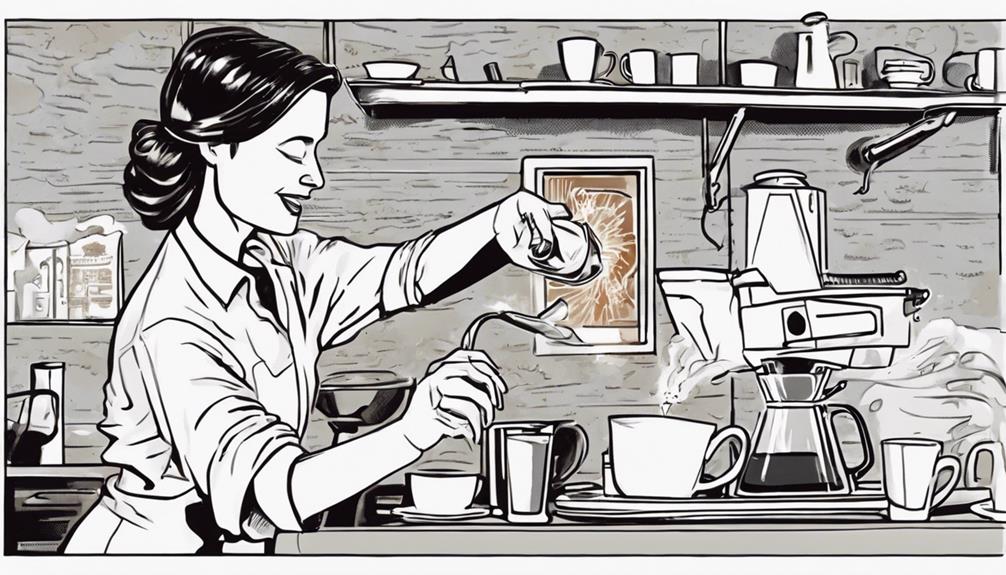
Achieving a clean cup in pour-over brewing requires attention to grind size, water temperature, and brewing technique.
To achieve a pristine drip coffee experience, follow these steps:
- Grind Consistency: Utilize a burr grinder to achieve a uniform grind size, allowing for optimal extraction and a clean cup of coffee.
- Water Temperature: Maintain the water temperature around 90°C to extract flavors effectively without scalding the coffee grounds.
- Agitation Levels: Experiment with different levels of agitation during brewing to enhance flavor extraction and achieve a balanced taste in your coffee.
- Brewing Factors: Consider variables like brew time, coffee-to-water ratio, and dose to fine-tune your pour-over technique and produce a clean and flavorful cup every time.
Frequently Asked Questions
How to Bring Out the Flavor in Flavored Coffee?
To bring out the flavor in flavored coffee, infuse syrups like vanilla, caramel, or hazelnut for a sweet taste. Try creamers or milk alternatives like coconut or almond. Sprinkle cocoa powder or cinnamon for added complexity.
How to Get More Flavor Out of Coffee?
To get more flavor out of coffee, explore adding warm baking spices or frothing milk for a luxurious texture. Elevate your brew by stirring in hot chocolate mix for a mocha twist. Experiment with citrus zest or a pinch of salt for balance and depth.
How Do You Intensify Coffee Flavor?
To intensify coffee flavor, try adding warm baking spices like cinnamon or nutmeg to your grounds before brewing. Shake warm milk for a frothy layer. Transform coffee into a mocha with hot chocolate mix. Sprinkle salt into grounds to balance bitterness.
What Can I Add to Coffee to Make It Taste Better?
To make your coffee taste better, sprinkle warm baking spices or citrus zest into your brew. Experiment with different combinations for a cozy experience and unique flavor profiles. Elevate your coffee game with a pinch of creativity!
Conclusion
You've just discovered the secret to revealing a symphony of flavors in your daily cup of coffee! By adding a pinch of spice, frothy milk, or a hint of citrus zest, you can transform your morning routine into a gourmet experience.
Say goodbye to bland coffee and hello to a world of delicious possibilities. Get ready to elevate your coffee game and savor every sip like never before!
-

 Ryze Coffee2 days ago
Ryze Coffee2 days agoRyze Mushroom Coffee Vs Other Brands – How Does It Compare?
-

 Espresso5 hours ago
Espresso5 hours agoHow Much Caffeine in an Espresso Shot? The Complete Guide!
-

 Vetted6 days ago
Vetted6 days ago15 Best Lavazza for Espresso
-

 Industry News1 week ago
Industry News1 week agoDoes Jacobs Coffee Support Israel?
-

 Ryze Coffee2 days ago
Ryze Coffee2 days agoRyze Mushroom Coffee Vs Everyday Dose – Which Is Better for You?
-

 Vetted6 days ago
Vetted6 days ago15 Best Instant Espressos for Drinking Anytime, Anywhere – Taste Test Results & Reviews
-

 Industry News1 week ago
Industry News1 week agoDoes Coffee Bean Support Israel?
-

 French Press1 week ago
French Press1 week agoUnderstanding How French Press Coffee Makers Work



























